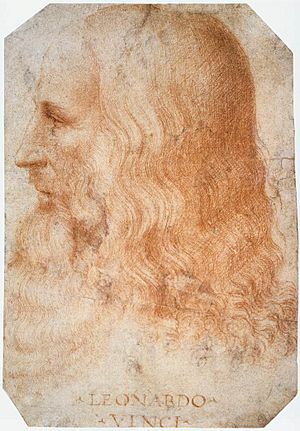Renaissance man facts for kids
The term Renaissance man or polymath is used for a very clever person who is good at many different things. The idea comes from a time of history called the Renaissance which lasted from about 1400 to about 1600. One of the most famous people alive during this time was Leonardo da Vinci. He was most famous as a painter, but he was also a scientist, engineer and mathematician. Leonardo is called a "Renaissance man". Another "Renaissance man" was Michelangelo, who was a sculptor, painter, architect and poet.
When the term "Renaissance man" is used, it does not mean that the man really lived in the Renaissance. It can be used for anyone who is very clever at many different things, no matter when that person lived. Albert Schweitzer was a 20th century "Renaissance man" who was a theologian, musician, philosopher and doctor. Benjamin Franklin was a "Renaissance man" who lived in the 18th century (1700s) and was an author and printer, politician, scientist, inventor and soldier.
List of polymaths
- Aristotle (Greek: Ἀριστοτέλης, Aristotélēs) (384 BC – 322 BC) was a Greek philosopher who studied and wrote about many subjects, including physics, metaphysics, poetry, theater, music, logic, rhetoric, politics, government, ethics, biology and zoology.
- Archimedes (Greek: Ἀρχιμήδης; c. 287 BC – c. 212 BC) was a Greek mathematician, physicist, engineer, inventor, and astronomer.
- Abū Alī ibn Sīnā (Avicenna) (980–1037), was a Persian physician, pharmacologist, philosopher, mathematician, astronomer, chemist, Hanafi jurist and theologian, scientist, statesman and soldier.
- Ibn Rushd (Averroes) (1126–1198), an Andalusian Arab philosopher, physician, jurist, astronomer, mathematician, and theologian.
- Roger Bacon, O.F.M. (c. 1214–1294), also known as Doctor Mirabilis (Latin: "wonderful teacher"), was an English Franciscan friar who was a philosopher, theologian and scientist. He was one of the first people to perform scientific experiments in a modern manner.
- Leonardo da Vinci (1452–1519) was an Italian painter, sculptor, engineer, astronomer, anatomist, biologist, geologist, physicist, architect, musician, philosopher and humanist.
- Michelangelo (March 6, 1475 – February 18, 1564) was an Italian Renaissance painter, sculptor, architect, poet, engineer and theologian (student of the Bible).
- Galileo Galilei (1564–1642) was an Italian scientist, mathematician, astronomer, physicist, and philosopher.
- Johann Wolfgang von Goethe (1749–1832) German writer, poet, critic, playwright, and novelist.
- Robert Hooke (1635–1703) was an English natural philosopher and architect. He was Gresham Professor of Geometry, Secretary of the Royal Society and surveyor to the City of London after the Great Fire. In addition to his law of elasticity, he was a founder of microscopy, and developed the world's first set of building controls. He designed many important buildings in London. He helped Robert Boyle to develop his gas law. He knew that fossils were petrified living things, and that gravity follows an inverse square law.
- Isaac Newton (1643–1727) was an English physicist, mathematician, astronomer, theologian, natural philosopher and alchemist. His development of calculus, and his three laws of motion were landmarks in applied mathematics.
- Gottfried Leibniz (1646–1716) was a German philosopher, theologian, physicist, mathematician, historian, librarian and inventor.
- Mikhail Lomonosov (1711–1765) was a Russian poet, educator, artist, physicist and chemist education.
- Thomas Jefferson (1743–1826). American president who was a horticulturist, architect, archaeologist, inventor, and founder of a university.
- Rabindranath Tagore (7 May 1861 – 7 August 1941) was a Bengali poet, artist, playwright, novelist, educationist, social reformer, nationalist, business-manager and composer.
- Sir Winston Churchill (30 November 1874 – 24 January 1965) was a British prime minister, military leader, historian, novelist, painter and sportsman.
- G. Spencer-Brown (2 April 1923 -) is a English mathematician and writer of Laws of Form.


